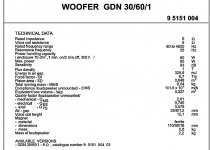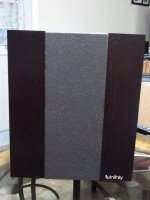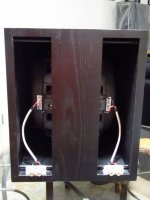Ah, yes. I forgot you had said that.
So, this worked much better than the ripoles you had tried in the past? Were you able to equalize the ripoles to account for the earlier rolloff from shorter path?
Also, you said that the inefficiency of the ripoles caused them to bottom earlier than other open baffles because they needed more power. It would seem that this would be offset by the added mass loading and cone control of the ripole and in the end all the different open baffle bass alignments would have similar max spl capabilities with same drivers and path lengths.
Is that not the case? I've even read people saying that the Ripoles will have high max spl than other non mass loaded open baffles because of the additional cone control. That's assuming the the driver's thermal power handling are still within limits.
It's hard to know what to believe just by reading the internetI did build a test non optimized ripole using Alpine 10" car subs I had on hand. I can say that they are extremely inefficient, but they did not seem to suffer from easily bottoming out. Connected to one channel of a pro amp 640W@4ohms, I had the gain at 3:00 with the preamp at 12:00
before I started getting decent volume out of it. Those drivers are only about 85db efficient on their own with around 12mm xmax. I think I read that you can lose as much as 10db efficiency in a ripole, does that sound about right to you?
Anyways, that was a fun experiment that gave me an idea what to expect. They sounded nice once dialed in a little. I measured a 10db quarterwave peak at around 240Hz that was very audible and annoying, but once that was notched and with a 140Hz xo applied they sounded surprisingly decent
By the way, thanks for the help.
The efficiency loss sounds about right. I think I did try eq'ing the ripole way back but it's been so long I don't remember for sure. I built 2 separate ripoles, one using a pair of low excursion 15" pro drivers (pyle PPA15) and the other using a single adire shiva 12" driver in a N-ripole configuration.
If you do wan't to try them, go for it and post back. I always encourage experiments.
1. As you've probably realized, pick a driver with a little lower Q than the typical OB driver. It does need to load the air in the slot, after all.
2. As you've already mentioned, a little EQ will be needed.
If the ripoles work, great. If they don't, you can always repurpose the drivers. Perhaps buy only enough drivers for one ripole (for starters).
Here's a guy who built them. I'm not certain but I vaguely remember that there might have been a thread about this build on this forum or audiocircle . You could try and contact the fellow.
Jazzman's DIY Electrostatic Loudspeaker Page: Ripole Subwoofers:
The efficiency loss sounds about right. I think I did try eq'ing the ripole way back but it's been so long I don't remember for sure. I built 2 separate ripoles, one using a pair of low excursion 15" pro drivers (pyle PPA15) and the other using a single adire shiva 12" driver in a N-ripole configuration.
If you do wan't to try them, go for it and post back. I always encourage experiments.
1. As you've probably realized, pick a driver with a little lower Q than the typical OB driver. It does need to load the air in the slot, after all.
2. As you've already mentioned, a little EQ will be needed.
If the ripoles work, great. If they don't, you can always repurpose the drivers. Perhaps buy only enough drivers for one ripole (for starters).
Here's a guy who built them. I'm not certain but I vaguely remember that there might have been a thread about this build on this forum or audiocircle . You could try and contact the fellow.
Jazzman's DIY Electrostatic Loudspeaker Page: Ripole Subwoofers:
Yes, I read the thread on Jazzman's ripoles. It's about the most complete thread that I've seen. Sounds like he's really happy with them. If I remember right, he's using carver amps to power them so, if he mentions the model number I can get an idea of their efficiency. One thing is that, like most people, he is using his as subwoofers to supplement his TL loaded woofers. I really don't understand the concept of using dipoles as subwoofers as they seem to lose efficiency and usefulness at sub frequencies and can't pressurize a room.
Anyways, if i do build the ripoles I'll probably start with only two drivers. I've heard a lot of questionable things about MCM's advertised specs, so I want to measure them myself to see if they are suitable. If I built something that needed less drivers then I would probably use nicer drivers with reliable specs.
Speaker for ripole
Friends,
First of all I would like to say I want to make similar construction as Jazzman did (Jazzman's DIY Electrostatic Loudspeaker Page: Ripole Subwoofers:)
Basic construction assumption is it will be bass part of 3 way system, all active. That said I would conclude that efficiency is not an issue as I can easily equalize it. The same regards crossover frequency change.
My question is if the speaker as below is suitable to use in ripole?
Thank you in advance for the answer
Friends,
First of all I would like to say I want to make similar construction as Jazzman did (Jazzman's DIY Electrostatic Loudspeaker Page: Ripole Subwoofers:)
Basic construction assumption is it will be bass part of 3 way system, all active. That said I would conclude that efficiency is not an issue as I can easily equalize it. The same regards crossover frequency change.
My question is if the speaker as below is suitable to use in ripole?
Thank you in advance for the answer
Attachments
Hi,
I´d say its a critical choice.
On the plus side are low mass, membrane area and Qt
On the minus side are soft suspension, low Fs and low excursion capability
The larger dimensioned Dipoles after Linkwitz or a open Baffle might be more suitable as the Fs doesn´t drop as much as in the smaller sized Dipoles after Ridthaler.
The low excursion limit rather asks for multiple driver setups, utilizing min.4 or more drivers per stereo channel.
Unknown remains the sonic behaviour of the driver.
Will it perform without, with low or with high noise?
The driver wouldn´t be my choice
jauu
Calvin
I´d say its a critical choice.
On the plus side are low mass, membrane area and Qt
On the minus side are soft suspension, low Fs and low excursion capability
The larger dimensioned Dipoles after Linkwitz or a open Baffle might be more suitable as the Fs doesn´t drop as much as in the smaller sized Dipoles after Ridthaler.
The low excursion limit rather asks for multiple driver setups, utilizing min.4 or more drivers per stereo channel.
Unknown remains the sonic behaviour of the driver.
Will it perform without, with low or with high noise?
The driver wouldn´t be my choice
jauu
Calvin
How does one go about measuring the position of the first quarter wave resonance peak? What kind of measuring equipment and setup satisfies this purpose?
According to Rudolf, the resonance peak is a function of the driver + ripole frame.
I am exploring a minimum sized frame to accomodate 2 x Peerless 830500 drivers. I'd like to use an active crossovers only.
Keeping the frame as small as possible, I have only calculated the estimated resonance frequency of the front (240hz) and back (250hz) chambers. I used a calculator for a vented box with no driver parameters. I used box volume = chamber volume, port area = cavity opening.
According to Rudolf, the resonance peak is a function of the driver + ripole frame.
I am exploring a minimum sized frame to accomodate 2 x Peerless 830500 drivers. I'd like to use an active crossovers only.
Keeping the frame as small as possible, I have only calculated the estimated resonance frequency of the front (240hz) and back (250hz) chambers. I used a calculator for a vented box with no driver parameters. I used box volume = chamber volume, port area = cavity opening.
Since the position of the first quarter wave resonance peak is a function of driver AND ripole frame, its exact value can only be determined by measurement. Being off 10 % can render the notch filter useless. So interpolating notch filter values from different published ripole dimensions or drivers is trial and error – well, mostly error.
How does one go about measuring the position of the first quarter wave resonance peak? What kind of measuring equipment and setup satisfies this purpose?
According to Rudolf, the resonance peak is a function of the driver + ripole frame.
I am exploring a minimum sized frame to accomodate 2 x Peerless 830500 drivers. I'd like to use an active crossovers only.
Keeping the frame as small as possible, I have only calculated the estimated resonance frequency of the front (240hz) and back (250hz) chambers. I used a calculator for a vented box with no driver parameters. I used box volume = chamber volume, port area = cavity opening.
I think the resonance is strictly a function of the frame. So the driver is unimportant in calculating the peak.
It's been I while since I built mine, but I think you can calculate it based on the length of the path difference. At 13" deep and 4" front pieces for a total foot print of 11"W x 13"D I think my peak was at 295Hz.
I measured mine with a dayton mic, behringer preamp, laptop and Rew. I placed the mic at the opening for the Ripole. This will give you the resonance peak(s) and the drivers natural roll off or Q. To truly see what kind of dipole loss you have to account for you need to measure a bit farfield, I think I did a ground plane measurement, but it's not going to be super accurate so you'll probably need to do some educated guessing and maybe in room measurements when they're in their final positions.
Well,
Here's my Q'n'D ripole calc sheet, mainly for cabinet construction though...
It's a preliminary V0.0001 alpha release
Send comments/improvements etc. to my email rather than here, I don't want to mess up this usefull thread!
regards, (Ri)Paul
Has anyone built a ripole using this spreadsheet?
How were the results?
Wouldn't that spreadsheet just be for a simple folded dipole design?Has anyone built a ripole using this spreadsheet?
How were the results?
It's my understanding that a true "Ripole" design (short for Axel "Ridtahler's Dipole") uses dual subs in an opposing push/push configuration where the front of each sub fires into a common center chamber and the rear of each sub fires into it's own dedicate chamber. That's what I recently built using a pair of Infinity REF1200S Low-Profile subwoofers so I wouldn't have to see those ugly magnets sticking out the sides of the enclosures.
Why is it that high Mms is not good for Ripoles?
It pulls down sensitivity.
That's what I recently built using a pair of Infinity REF1200S Low-Profile subwoofers so I wouldn't have to see those ugly magnets sticking out the sides of the enclosures.
Any measurements?
I use a MiniDSP DDRC-24 in my setup for room correction. According to the frequency response from it a single Ripole sub (the 2nd is in it’s finishing stages) along with my Magnepan 1.5QRs are flat down to 27Hz. While this doesn’t go down into pipe organ territory (I don’t listen to that sort of thing anyway) it is a HUGE improvement over my Maggies alone. I agree with a statement made by “Jazzman” (Google “Jazzman’s Ripole") that you should not expect chest thumping, room shaking bass like you would hear at a movie theater from a Ripole. Taking that into consideration the added bass provided by the Ripole sub blends beautifully with my Maggies.
Attachments
The rule of thumb here is: If the drivers Xmax (peak-to-peak) is >10 mm, the opening area of the pipe should be not less than 1/3 Sd. If Xmax is less, the area might be reduced down to 1/4 Sd.
Rudolf
This does not make sense to me.
I thought X-Max was one way and peak to peak was both ways.
?
hello, I try to read with interest the interesting subject. I would like to do a ripole project, I was wondering if these Audax PR240M0 speakers will be suitable. thank you for your comments, Hervé.
Haut-parleur Audax PR240M0, 8 ohm, 279 mm
Haut-parleur Audax PR240M0, 8 ohm, 279 mm
- Home
- Loudspeakers
- Subwoofers
- Drivers / parameters for ripole subs


